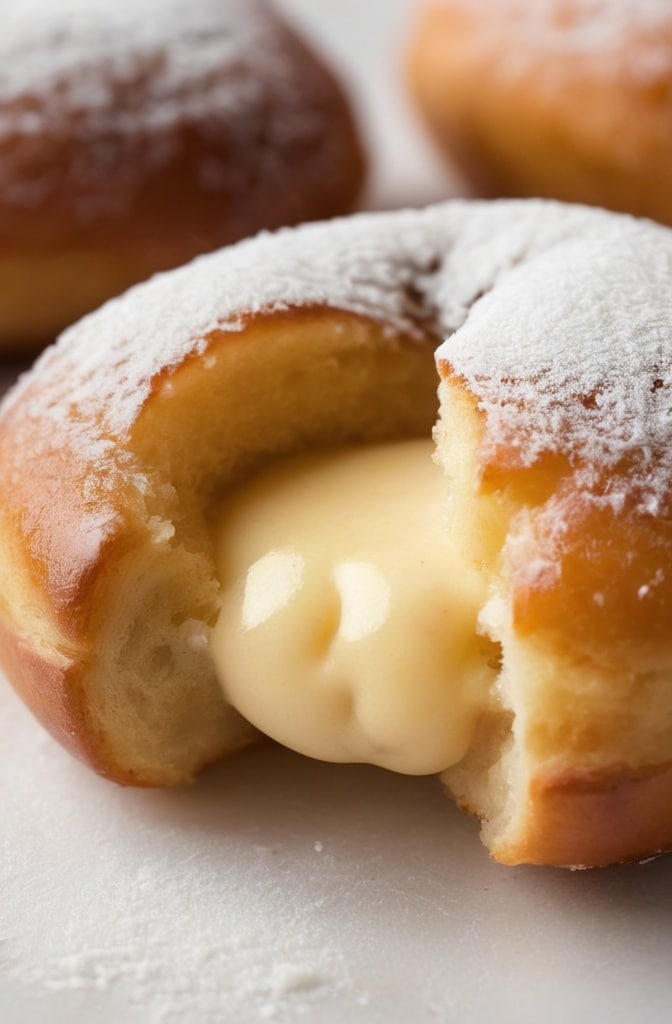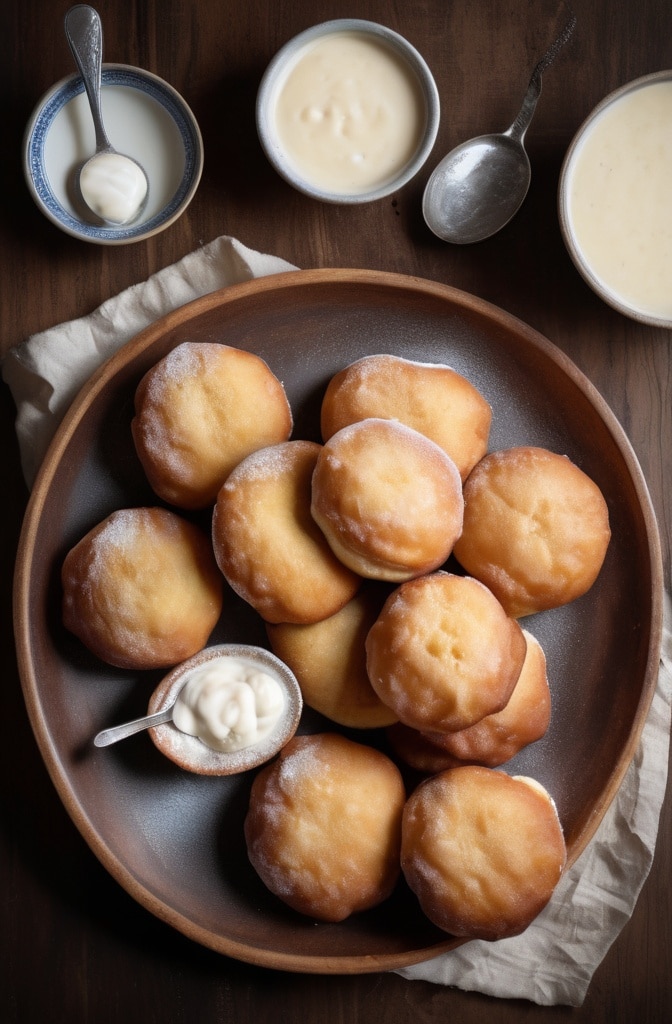The first time I sank my teeth into a freshly made malasada standing in a bustling Portuguese bakery in Maui, of all places—I knew I had stumbled upon something special. That moment marked the beginning of my journey to discover irresistible Portuguese malasadas. The warm, pillowy doughnut coated in granulated sugar melted in my mouth, leaving behind a whisper of lemon and an undeniable longing for another bite.
This isn’t just any doughnut—it’s a cultural icon with roots stretching back to the Azores islands of Portugal, where families have perfected these treats over generations.
Malasadas (pronounced mah-lah-SAH-dahs) are Portuguese-style doughnuts without holes, traditionally served on Shrove Tuesday before Lent begins. But these days, why limit yourself to just one day a year? Theyre too good for that kinda restraint.
The Magic of Malasadas
What makes malasadas special is their perfect contradiction: a slightly crisp, sugar-crusted exterior giving way to an airy, tender interior. Unlike American doughnuts, traditional malasadas contain no filling, allowing the subtle flavor of the enriched dough to shine through. However, contemporary versions often feature delicious fillings like coconut custard, guava, or chocolate.
The secret to authentic malasadas lies in the dough’s overnight fermentation. This process not only develops complex flavors but also creates that distinctive chewy-yet-tender texture that sets them apart from ordinary donuts. It’s worth noting that patience here isn’t optional—it’s essential for perfection.
Ingredients & Substitutions
For the Dough:
- 4 cups (500g) all-purpose flour
- 1/2 cup (100g) granulated sugar
- 1/4 teaspoon salt
- 2 1/4 teaspoons (7g) active dry yeast
- 1/4 cup (57g) unsalted butter, melted
- 1 cup (240ml) whole milk, warmed to 110°F (43°C)
- 6 large egg yolks, room temperature
- 1/4 cup (60ml) evaporated milk
- 1 tablespoon vanilla extract
- 1 tablespoon lemon zest (from about 1 lemon)
- 1/4 teaspoon nutmeg (optional but recommended)
For Frying:
- 4 cups (960ml) vegetable oil or canola oil
For Coating:
- 2 cups (400g) granulated sugar
- 1 tablespoon ground cinnamon (optional)
The quality of your flour matters tremendously here—a higher protein content (around 11-12%) creates the perfect chew. King Arthur all-purpose flour works beautifully, but if unavailable, bread flour cut with a bit of cake flour achieves similar results.
For those avoiding dairy, coconut milk can replace whole milk for a subtle tropical note, and plant-based butter substitutes work well. The egg yolks are harder to replace without compromising texture, but for those with allergies, a commercial egg replacer will work better than applesauce or flax eggs in this perticuler recipe.
The evaporated milk adds richness that’s difficult to replicate, but in a pinch, half-and-half or even additional whole milk reduced by simmering for 10 minutes will suffice. Don’t skip the lemon zest—it’s not there to make the doughnuts taste lemony, but rather to enhance the overall flavor profile in a way that’s subtle yet distinctive.
Step-by-Step Instructions

Day 1: Prepare the Dough
- Activate the yeast by combining it with 1/4 cup of the warmed milk and a pinch of the sugar in a small bowl. Let it sit for about 5-7 minutes until foamy. If it doesn’t foam, your yeast might be dead, and you’ll need to start over with fresh yeast.
- In a large mixing bowl, combine flour, remaining sugar, salt, and nutmeg if using. Create a well in the center for the wet ingredients. This method prevents flour from flying everywhere and helps with gradual incorporation.
- In a separate bowl, whisk together the egg yolks, evaporated milk, remaining warm milk, melted butter (cooled slightly so it doesn’t cook the eggs), vanilla extract, and lemon zest until smooth.
- Pour the yeast mixture and the egg mixture into the well of dry ingredients. Mix with a wooden spoon until shaggy, then switch to hands and knead in the bowl for about 2 minutes. The dough will seem too wet at first—resist the urge to add more flour immedeately.
- Transfer the dough to a lightly floured surface and knead for 5-7 minutes until smooth and elastic. The dough should be soft and slightly tacky but not sticking to your hands aggressively. If it’s too wet after a few minutes of kneading, add flour a tablespoon at a time. A properly kneaded dough will bounce back slowly when poked.
- Place the dough in a greased bowl, turning once to coat. Cover with plastic wrap and refrigerate overnight (at least 8 hours, preferably 12-18). This slow fermentation is crucial for developing flavor and texture.
Day 2: Shape and Fry
- Remove the dough from the refrigerator and let it sit at room temperature for 1 hour to warm up slightly. The cold dough will be easier to handle initially but needs to warm a bit before frying.
- Line two baking sheets with parchment paper and dust lightly with flour. Turn the dough onto a lightly floured surface and press it down gently to deflate.
- Using a bench scraper or knife, divide the dough into 16 equal pieces (about 60g each for uniformity). For traditional malasadas, shape each piece into a ball by gathering the edges toward the center and pinching to seal, then rolling between your palms to create tension on the surface. For a more rustic look, simply form rough balls.
- Place the dough balls on the prepared sheets, leaving at least 3 inches between each. Cover loosely with clean kitchen towels and let rise in a warm spot for 30-45 minutes until puffy but not necessarily doubled.
- While the dough rises, prepare your frying station. Heat oil in a heavy-bottomed pot or dutch oven to 350°F (175°C). Use a thermometer for accuracy—temperature control is absolutely critical for perfect malasadas. Too cool, and they’ll absorb excess oil; too hot, and the outside will burn before the inside cooks.
- Mix sugar (and cinnamon if using) in a shallow bowl for coating. Have a cooling rack set over a baking sheet ready nearby.
- When ready to fry, carefully stretch each ball into a rough 4-inch disc. Don’t worry about making perfect circles—the irregular shape is part of their charm! The stretching helps create the characteristic airy interior.
- Carefully lower 2-3 dough discs into the hot oil, being careful not to crowd the pot. They should immediately begin to puff and float. Fry for 1-2 minutes per side until deep golden brown, using wooden chopsticks or a spider strainer to flip them.
- Remove the malasadas with a slotted spoon, letting excess oil drip back into the pot for a few seconds. Immediately toss in the sugar mixture while still hot to ensure maximum adhesion.
- Transfer to the cooling rack and let cool just enough that you won’t burn yourself—malasadas are at their absolute peak when still warm.
A common mistake is frying at too high a temperature, which results in a dark exterior and raw interior. If your first batch turns dark too quickly, reduce the heat slightly and wait for the oil to adjust before continuing. Conversly, if they’re taking more than 2 minutes per side to brown, your oil is probably too cool.
Cooking Techniques & Science
The science behind perfect malasadas is fasinating. The overnight fermentation allows the gluten to relax while simultaneously developing complex flavors through enzymatic activity. The yeast slowly consumes the sugars, producing carbon dioxide that gets trapped in the gluten network, creating those signature air pockets.
The high egg yolk content serves multiple purposes: tenderizing the dough by coating the gluten strands with fat, providing richness, and contributing to the golden color. The addition of evaporated milk introduces milk solids that caramelize during frying, enhancing both color and flavor.
When frying, the sudden heat causes moisture in the dough to convert to steam, creating the dramatic puff that gives malasadas their airy interior. This rapid expansion, combined with the developed gluten structure from proper kneading, results in that perfect chewy-yet-tender texture.
Temperature control during frying is non-negotiable. I recommend using a heavy-bottomed Dutch oven, which retains heat well and prevents temperature fluctuations when adding dough to the oil. A deep-fry thermometer is your best friend here—don’t attempt this recipe without one.
The immediate sugar coating while the malasadas are hot serves a dual purpose: the residual heat melts the sugar just enough to create that characteristic crunchy-sweet exterior, while also helping to absorb any surface oil.
Filling Variations
While purists (including many Portuguese grandmothers) would argue that authentic malasadas need no filling, contemporary versions often include delicious options. If you’d like to fill yours:
- Allow the sugar-coated malasadas to cool completely.
- Using a small paring knife, make a small incision in the side of each malasada, or use a piping tip to create a hole.
- Fill a piping bag fitted with a medium round tip with your choice of filling and pipe approximately 2 tablespoons into each malasada.
Some traditional and modern filling options include:
- Coconut Custard (Haupia): A Hawaiian-Portuguese fusion that’s become a classic
- Vanilla Pastry Cream: Simple yet sophisticated
- Guava Paste: Thinned slightly with water for a tropical twist
- Lemon Curd: Bright and tangy
- Chocolate Ganache: Rich and decadent
- Passion Fruit Curd: Exotic and vibrant
Serving & Pairing Suggestions
Malasadas are traditionally served hot, just minutes out of the fryer, when they’re at their absolute peak of perfection. In Portugal, they’re often enjoyed with a strong bica (espresso) to balance the sweetness. In Hawaii, where Portuguese immigrants brought malasadas in the 19th century, they’re commonly paired with rich Kona coffee.
For a delightful breakfast spread, serve fresh malasadas alongside fresh tropical fruits like mango and pineapple, which provide a refreshing contrast to the rich doughnuts. The acidity cuts through the sweetness beautifully.
For presentation, a simple approach is best: serve them piled high on a platter lined with vintage doilies or banana leaves for a touch of Portuguese or Hawaiian flair. The rustic, imperfect shape of hand-stretched malasadas makes them inherently beautiful—no need for fancy decorations.
If you’re serving them as dessert, consider a scoop of vanilla ice cream alongside warm malasadas, perhaps with a drizzle of salted caramel sauce. The temperature contrast is absolutely divine.
Make-Ahead and Storage Tips

Malasadas are undeniably best fresh, but the dough itself can be prepared up to 24 hours ahead and kept refrigerated. In fact, many bakers insist that a full 24-hour fermentation produces the most flavorful results.
If you need to make them further in advance, the shaped dough balls can be frozen before the final rise. Place them on a baking sheet until solid, then transfer to a freezer bag. Thaw overnight in the refrigerator, then allow to come to room temperature and rise before frying.
Fried malasadas will keep for about 24 hours in an airtight container, though they’ll gradually lose their crisp exterior. To refresh day-old malasadas, warm them in a 300°F (150°C) oven for about 5 minutes. They won’t be quite as magnificent as fresh, but they’ll still be delicious.
Cultural Significance
In Portugal, particularly in the Azores islands, malasadas are deeply intertwined with Carnival celebrations. The tradition of making malasadas on Shrove Tuesday (known as Malasada Day or Terça-feira Gorda) began as a practical way to use up sugar, butter and eggs before the fasting period of Lent.
When Portuguese immigrants—primarily from the Azores—arrived in Hawaii in the late 19th century to work on sugar plantations, they brought this tradition with them. Today, malasadas are as much a part of Hawaiian food culture as they are Portuguese, with specialized bakeries drawing long lines of eager customers.
The name “malasada” itself comes from the Portuguese “mal-assada,” which literally means “poorly-cooked” or “under-cooked,” referring to the doughnuts’ soft interior. Despite this humble name, mastering the perfect malasada is considered a point of pride in Portuguese and Portuguese-American households.
Conclusion
Creating authentic Portuguese malasadas at home connects you to centuries of culinary tradition spanning from the Azores to Hawaii and beyond. The process requires patience—that overnight fermentation isn’t optional—but the results are incomparable to any quick doughnut recipe.
The keys to success are respecting the fermentation time, handling the dough gently to preserve those air pockets, maintaining precise oil temperature, and serving them at their peak—fresh and warm from the fryer. Master these elements, and you’ll create malasadas that rival those from specialized bakeries.
Remember that perfect malasadas show their handmade quality through slight irregularities in shape and size. These aren’t meant to be uniform factory productions—each one should have its own character, its own story to tell.
Whether you enjoy them in their purest form, simply coated with sugar, or filled with luscious custards and curds, malasadas offer a taste of Portuguese heritage that’s truly worth the effort. As we say in Portugal, “Bom apetite!”
FAQs About Discover Irresistible Portuguese Malasadas
Can I make the dough without an overnight rest?
While technically possible, skipping the overnight fermentation will result in malasadas that lack depth of flavor and proper texture. The slow fermentation is essential for developing the characteristic chew and complex taste. If you’re in a rush, a minimum 4-hour refrigeration will provide some benefits, but overnight is strongly recommended for authentic results.
Why are my malasadas dense instead of light and airy?
Dense malasadas usually result from either insufficient kneading (which develops the gluten structure necessary for those air pockets) or overworking the dough during shaping. Be sure to knead until the dough passes the “windowpane test”—a small piece should stretch thin enough to see light through without tearing. Also, handle the dough gently after fermentation to preserve the air bubbles that have developed.
Can I bake malasadas instead of frying them?
Traditional malasadas are always fried, which creates that distinctive contrast between crisp exterior and fluffy interior. While you could technically bake them at 375°F (190°C) for about 12-15 minutes, the result would be more like sweet rolls than true malasadas. The characteristic texture comes from the rapid heat transfer that only frying provides.
How do I know when the oil is at the right temperature without a thermometer?
While a thermometer is strongly recommended for consistent results, you can test the oil by dropping in a small piece of dough. It should rise to the surface within seconds, surrounded by bubbles, and begin browning in about 1-2 minutes. If it browns too quickly, the oil is too hot; if it absorbs oil and stays pale, the oil is too cool.
Why did my malasadas deflate after frying?
Deflated malasadas typically result from under-proofing (not allowing enough rise time before frying) or frying at too low a temperature. Make sure your dough balls are noticeably puffy before frying, and maintain a steady oil temperature of 350°F (175°C). Also, avoid overcrowding the pot, which can cause the oil temperature to drop too rapidly.

